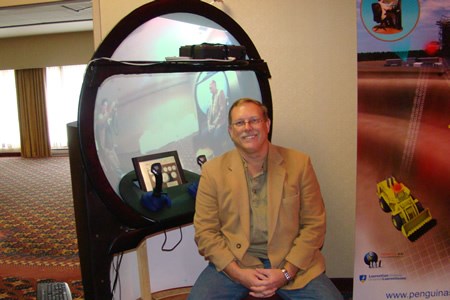The use of light as a new system of communication between computer systems is just one of the homegrown examples of innovation on display at this year’s International Conference on Mechatronics Technology (ICMT 2008), held in Sudbury from Oct. 14 - 17.
More than 100 of the world’s leading minds in the field of mechatronics attended the event, making this 12th conference the first time it has taken place outside the Pacific Rim. Traditionally, it has been held in places like Mexico, Korea, New Zealand and Australia, while next year’s event is slated to take place in Manila, in the Philippines.
“These are the places where cutting-edge work in the field is taking place, and to be counted among that group is quite prestigious,” says Dr. Greg Baiden, who co-chairs the event with Laurentian University research associate Dr. Yassiah Bissiri.
“It’s neat to have Sudbury and Laurentian considered in that, and being able to show off some of the things that we’re doing to these global experts is really quite cool.”
Having frequently presented at previous iterations of the annual conference, Baiden put in a successful bid for Canada to host the event. Given his status as a Canadian Research Chair in Robotics and Automation at Laurentian University, along with his work on commercializing that research through his local company, Penguin ASI, Sudbury was the logical host location.
Bringing this world-class event to the North encouraged organizers to infuse the proceedings with a distinctly Northern feel, with special relevance to the region’s industries.
With “Applications of Mechatronics to Natural Resources” as its theme, the event explored the potential role that this advanced field of robotics could play in helping to solve problems seen across such sectors as mining and forestry.
By encouraging discussion between these leading scientists and attendees from industry, such as event sponsor Barrick Gold, organizers hope that new topics for mechatronics research may emerge.
With sessions ranging from bioengineering to human resources and development, presentations included talks on using mechatronics to assist in underground mine planning and design, as well as measuring wood surface finish in real time.
“The best way to think of it is that when you bought a car 10 years ago, it was just a box with no computers in it, but now you can’t buy one without all these digital gauges and all those things,” says Baiden. “There’s no reason to believe that the mining equipment and forestry equipment and farming equipment won’t go down that path too, and if we’re going to have those things happening around us, we’d better be a part of them.”
Examples of this kind of cutting-edge research were on display at the event, including one instance of the many innovations Baiden is undertaking at the heart of Penguin ASI in partnership with Laurentian University.
This includes the development of an entirely new communications system which relies upon the use of light to transmit information, rather than the traditional use of radio waves.
Having patented this technology around the world, Baiden says it could eventually allow for the operation of space tools such as the Canadarm from the Earth’s surface.
Practical uses have already been devised in-house for this new technology, including the “virtual insertion” of people into robotic machines.
One example on hand at the conference featured a small excavation vehicle mounted with a special camera, as well as a transmitter which flashes a series of red LEDs 40 million times per second, translating the video information into light. This light is then captured and translated back into video by a nearby receiver.
The video is then projected in real-time onto a large concave surface, under which the operator can use a pair of joysticks to remotely control the machine. This setup provides the operator with a sense of virtually being there by “experiencing” what the machine “sees.”
“You can think of the virtual reality ride at Science North, but what we’re doing is the same thing except we’re not running a simulator that you’re watching,” says Baiden. “We’re providing real-world information to run the machines.”
The technology has particular promise for any number of uses in underwater environments, he says, ranging from mining applications to construction to security through the monitoring of harbors and other seaways.
This light-based technology has already seen some separate private-sector adoption through a company in Massachusetts, which is seeking to enhance their underwater modem technology.




